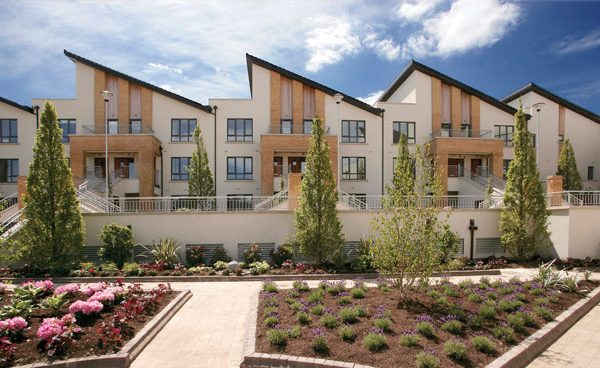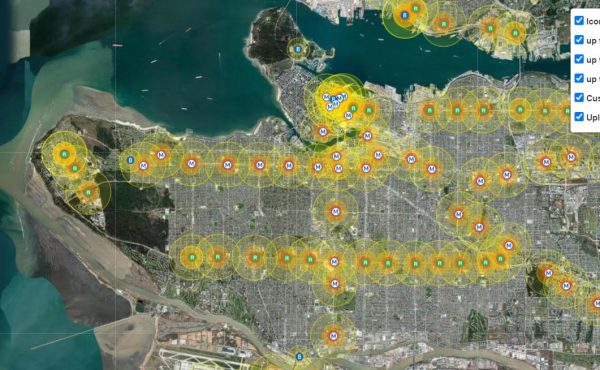
The last in our series on Burnaby’s urban centres (Brentwood, Lougheed, Edmonds) based on the work of David Pereira. This week: Metrotown. (David’s full analysis is here.)
This regional town centre arguably has its roots in depression and war:
In December of 1932, the municipality’s financial situation became so dire, that the Provincial Government was forced to take control of Burnaby’s affairs, temporarily terminating the function of the Reeve and Council. The municipality’s governance structure was returned in 1942 when the municipality once again became solvent. But before this occurred, Provincial officials and municipal commissioners had struck a deal with the Ford Motor Company in 1938 to begin producing military vehicles for the impending Allied effort during World War II.
Ford was joined by food-processor Kelly-Douglas and, in 1954, Sears. Here’s this collection of large-lot industrial properties in 1956:
.
By the 1970s, it was considered ready for redevelopment. But, in a way that distinguishes Burnaby, the municipality has already anticipated the change with its 1966-69 apartment studies.
On July 2, 1974 during a special meeting of Council, Burnaby Council passed the recommendation to move the creation of the municipality’s first Metrotown towards reality ….
[Here’s an intriguing footnote: Before Larry Beasley became an internationally recognized urban planner, he was interested in what was happening in Kingsway-Sussex (as Metrotown was labelled at that time) through his Master’s thesis, A Design Probe Comparison of Regional and Municipal Attitudes Toward Regional Town Centres: Case Study in Burnaby, B.C.]
But because Metrotown emerged so early (well before rapid-transit was likely), Burnaby hedged its bet:
… municipal planners were leery about how soon the region would receive the transit system that was seen as the lynchpin in the Livable Region plan. As such, the Metrotown concept was modified to depend more greatly on automobile transit and a balanced share of modes (including vehicular) than the RTC concept was envisioned for.
In 1977, with the assistance of Norman Hotson Architects, Burnaby released Burnaby Metrotown: A Development Plan – the same year the firm also released an update to the Granville Island redevelopment plan. But the Metrotown plan had a very different conception of pedestrian treatment:
Because rerouting Kingsway was not a feasible option due to external realities (Provincial highways jurisdictional issues), planners proposed a work-around. They suggested that the “design concept should provide […] a separation of important pedestrian ways from direct vehicular influence,” presumably a reference to elevated pedestrian walkways.
The planners at this point wanted to foster pedestrian connectivity within a centralized core, bounded on one side by transit and the other by a roadway. The Town Centre could take advantage of a rapid transit line located along the old interurban right of way, with an underground station that would pass underneath.
“So,” David ask: “Why does Kingsway-Sussex look so different today?”
The answer is in politics, recession and developer dreams (and failures) – all detailed here (including a proposal for a Fantasyland in competition with Metrotown, to be constructed by the developers of West Edmonton Mall.) Councils rose and fell on their decisions concerning the future of this town centre, how it would be shaped and who would do it. All the backroom politics, including those in Victoria and downtown Vancouver, are revealed.
Concludes David:
It took Vanouver 150 years to develop its downtown core into the comprehensive, internationally recognized core it is today. For Metrotown and Burnaby’s other Town Centres, it has only been 46 years since the 1966 Apartment Studies, and only 25 years since Edmonds’ designation. But even more notable than the pace of the development is the type of development, again: a dense, mixed use (some more striving than others), highly transit-dependent pattern.
Actually, that’s not the conclusion at all: Metrotown is already starting to reinvent itself. The least successful of the three internal malls is being rethought:
Buoyed by extremely strong interest particularly from Southeast Asian immigrants, the area has experienced a flurry of development, including two large mixed-use towers and an ambitious redevelopment proposed for Anthem Properties’ Station Square. The project, in partnership with the Beedie Group, will result in the renovation of existing retail spaces and the addition of office space and five residential towers. The 4.1 hectare site will house an additional 1,500 to 1,800 residents by 2020.






One comment
Fascinating history and breathtaking in its detail (as seen in Pereira’s original post). I worked at Sear’s mail order warehouse for over five years (Sept ’79 – Jan ’85) before they closed it to redevelop it as Metrotown mall phase one. The timing was sweet as my undergrad years were over, and so was my need for part time work at Sears. It’s been amazing to watch Metrotown evolve ever since.